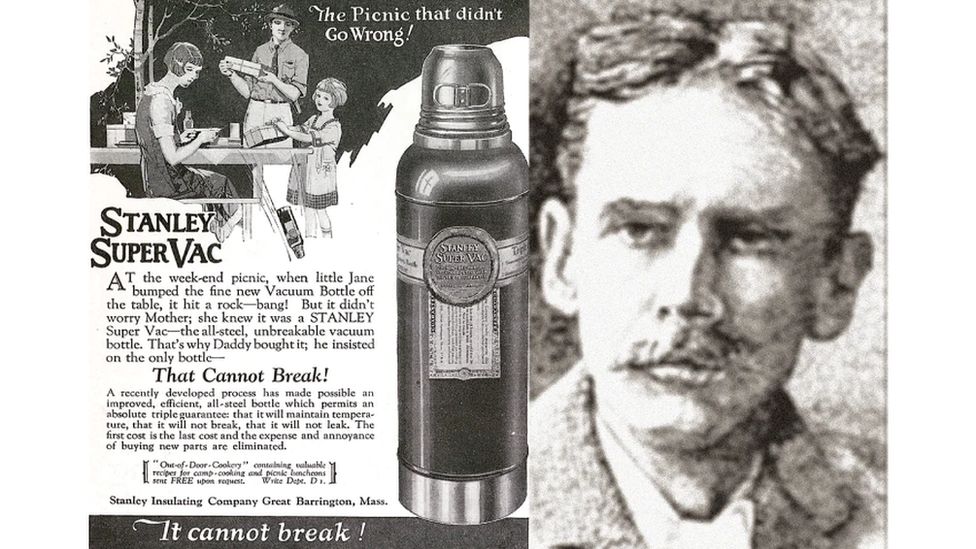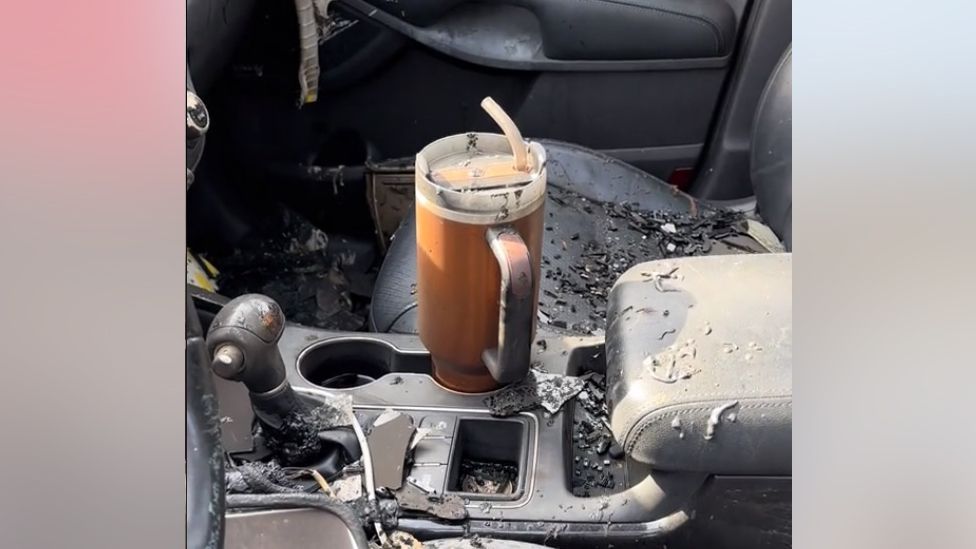
By Jonelle Awomoyi
Host, Reliable Sauce podcast
Would you camp outside a supermarket for a water tumbler that has gone viral on TikTok?
Increasingly, viral buzz means the answer for some is yes, but only if it is a Stanley cup – specifically, the Adventure Quencher Travel Tumbler.
TikTokers in the US documented their experience queuing overnight at a Target supermarket car park in an effort to secure a special Starbucks edition, which retails at an eye-watering $54.50 (£42.99).
The #StanleyCup hashtag now has 7.2 billion views worldwide and is also gaining popularity in the UK on the video-sharing platform.
Thirst for the craze has even seen people resort to attempts at law-breaking, with one popular video showing a man jumping across a Starbucks counter in an effort to steal a hot pink limited edition of the flask.
Making a splash
The Stanley cups, known for their large handle and distinguished straw, were first popularised by eco-friendly, health-conscious, often teenage TikTokers who frequent the platform’s #watertok community, wrote the New York Times in 2022.
The bottle is not the first to become a hit with the public as society becomes more sensitive to single-use plastic – Chilly’s reusable bottles, as well as branded Love Island tumblers, made famous on the show, were previous on-trend items.
The boom in interest has reaped huge financial rewards for Stanley 1913, the drinksware company behind the model.
According to CNBC estimates, profits are likely to rise significantly, as sales for the last year are set to hit about $750m, a sharp increase from the $70m in annual sales made in 2020.

Analysts attribute a large part of the product’s recent success to the company’s president, Terence Reilly, who was appointed back in 2020, having previously been chief marketing officer for Crocs footwear.
The role saw him credited with transforming the previously maligned shoe into a bold fashion statement, and now he seems to be overseeing the same shift for drink bottles.
“Most of his television time has been replaced by watching TikToks,” wrote Ali Donaldson in his Inc. business profile of the executive. “With his track record of driving viral levels of consumer demand, Reilly knows how to reinvigorate brands into online sensations.”
Stanley 1913 was originally founded in its namesake year by William Stanley Junior. An early advert for its bottle design boldly stated it “cannot break!”.

More than a century later, this claim was put to the test last year when TikTok user @danimarielettering filmed the interior of her burnt-out car, only to find her Stanley cup firmly intact by the driver’s seat. She then shakes it, indicating that ice remains inside.
The novelty saw the video rack up a huge 94.8 million views, with the apparent extreme durability of the flask becoming a talking point.
However, while the bottle appears able to endure fire reasonably well, some creators have pointed out that the tumbler is susceptible to leaks if knocked over.
In response, Stanley 1913 told the BBC’s Reliable Sauce podcast: “The Stanley Adventure Quencher is not leak or spill-proof. It has a silicone seal around the straw base designed to help prevent spills. But the lid is not designed to be 100% leak-proof, but help prevent spills and splashes.”

For some TikTok users, this apparent defect is enough for them to try other products they spot online, especially with competing brands constantly fighting for attention on social feeds.
And a Guardian article on a growing backlash saw the craze dismissed as an infantilising obsession with “adult sippy cups”.
Purchase power?
But how much do the videos that TikTok users see on their “for you” page actually sway their purchasing habits?
Market intelligence agency Mintel told the BBC that 86% of Gen Z social media users feel these platforms influence their fashion choices.
US singer-songwriter and actress Olivia Rodrigo, 20, admitted to GQ magazine that TikTok spurred her into buying a Stanley cup. “I was like, I need this, it looks like it’s going to change my life,” she said.
Of course, Stanley cups are far from the first brand to benefit from online hype. In recent months we have seen a surge in popularity for Prime Energy drinks (popularised by KSI and Logan Paul), as well as Ugg boots, AirPod Max headphones, Telfar bags… and even feta cheese.
But this hype culture also feeds into dupe culture – “dupe” standing for duplicate – and the promotion of purchasing knock-off versions of more expensive items.
And 65% of 16 to 34-year-old beauty and personal care shoppers think product dupes are a good way to save money, according to Mintel.
So, it seems users who have been using TikTok as a search engine (an emerging trend) may well soon be lured towards knock-off Stanley cup alternatives.
At least this would save waiting overnight in a car park.https://tehopeng.com/